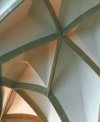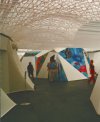Orthogonal structures are commonly considered as being easy and economical to construct.
As we will see, this does nī t always hold true. Indeed the walls usually are perpendicular to the horizontal bottom, as well as the furniture is rectangular. This saves room. But people move freely through space and not aligned in right angles by a square - similar to frequently reflected sounds and lights.
Built spatial forms are not only interesting and sometimes spectacular, because they offer more design features. They also satisfy complex spatial demands. Unfortunately they require more effort during the time in planning and realisation if constructed in a conventional way. That' s why you don' t encounter them in everyday life but rather in either sacred buildings or event structures.
Even pioneers of free-form design like for example Frank Gehry, Reiser + Umemoto or Greg Lynn were forced to change their organic forms into crystalline ones in order to get them built.
However, the proposal being presented here is that complex geometries can be mastered by means of prefabrication based not only on regular, reduced shapes, but also on novel structural systems that correspond to the shape more accurately.
On principle, rounded and oblique forms are more suitable for homes, roofs or large-span buildings because they can be shaped according to static and dynamic loads and because they have less enveloping surface in relation to the enclosed volume. That equally saves material and heating energy.
So far, forms being structurally optimised as a whole as the geodesic domes invented by R. Buckminster-Fuller often are isolating themselves against the exterior. They are hard to extend or to integrate in any urban context.
The building system that is being presented here overcomes those limitations. Joinings to conventional walls with openings and to rectangular buildings are also possible now.

|
|






